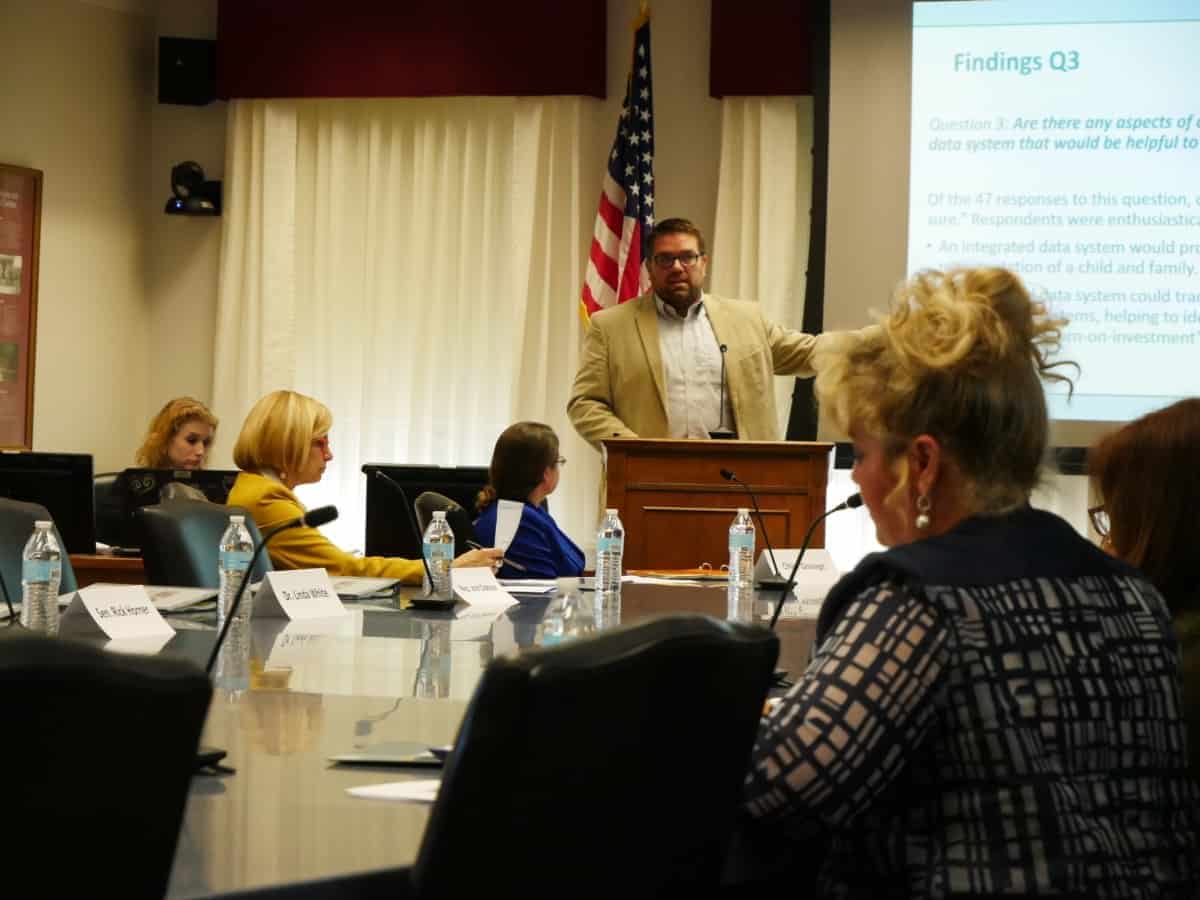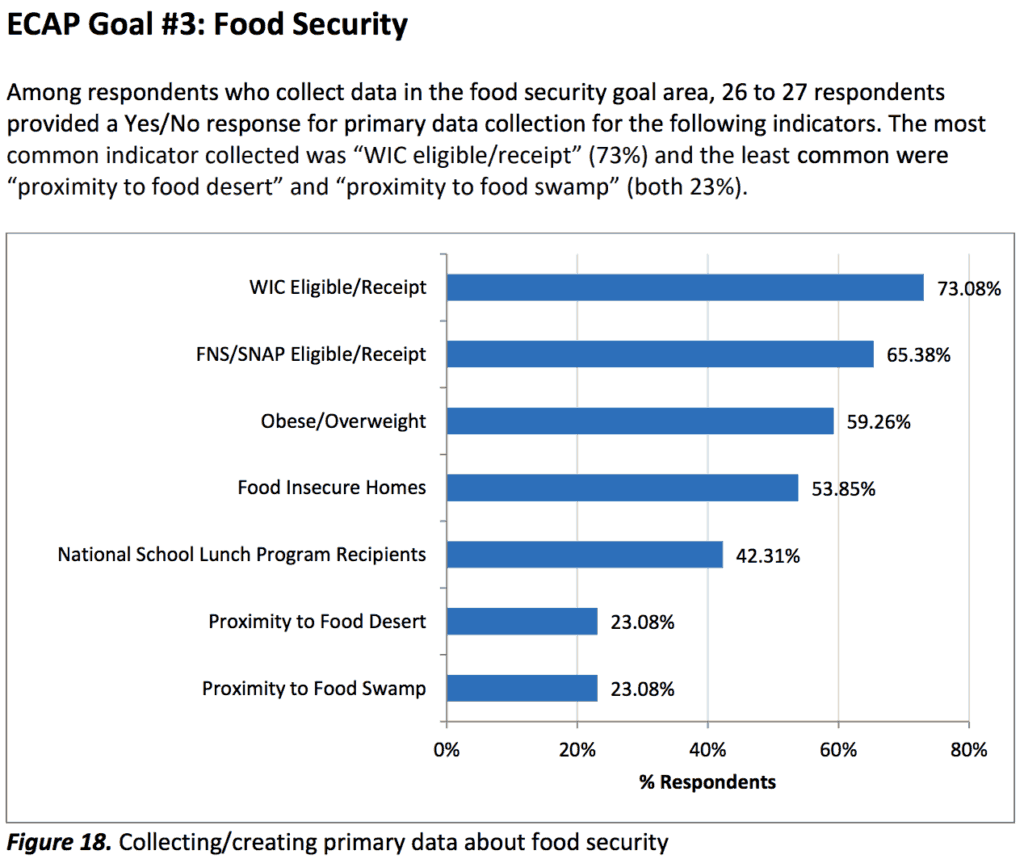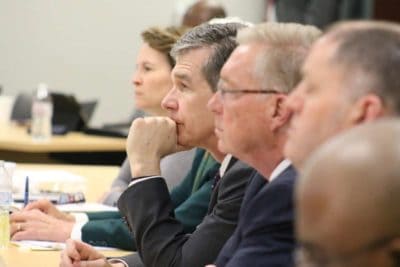
For the first time since March, a council working to bridge the worlds of early childhood and early elementary education met Wednesday to further its creation of a plan to coordinate education and development services for children from birth to third grade.
Early childhood and K-12 fall under two government agencies in North Carolina — the Department of Health and Human Services (DHHS) and the Department of Public Instruction (DPI), respectively. Both at the state level and on the ground, the two systems are often disconnected.
Preschool and kindergarten teachers and administrators often do not share useful information about students. There is no statewide data system across the two systems to inform policy decisions. And both educator preparation and compensation look different in the early childhood and early elementary workforces.
Here are four takeaways from Wednesday’s B-3 Interagency Council meeting on ways policymakers and practitioners are working to increase coordination and to strengthen student outcomes.
1. Legislators are forming an early childhood caucus.
All General Assembly members will be invited to a legislative caucus focused on early childhood issues in and out of the classroom. Rep. Craig Horn, R-Union, said Wednesday that a steering committee is being formed.
“The purpose of the early childhood caucus is to, first and foremost, inform the legislators, get them to speak the language, and get them thinking deeply about early childhood — and notice I didn’t say early childhood education; I said early childhood,” Horn said.
Horn said the caucus will work with early childhood advocates and funders to create a legislative agenda for next session, as well as an ongoing agenda on early childhood issues. Rep. Ashton Clemmons, D-Guilford, is at the front of the caucus’s creation, he said. While the B-3 Interagency Council’s work involves systemwide recommendations, he said the caucus will work to move specific policy items through the legislature.
“Each and every legislator will be invited to participate and become aware of challenges, the opportunities, and what role the legislature can play, perhaps should play,” Horn said.
2. Everyone is concerned about data systems.
Paul Lanier, associate professor at UNC-Chapel Hill’s school of social work, presented results from a survey of data users across the early childhood space that garnered about 200 participants, most of whom work in early education. The survey looked at how folks collect and/or use primary, secondary, and integrated data, what barriers individuals have to accessing data, and how the data we collect matches up with the statewide Early Childhood Action Plan. You can find the full results here. The results led to four recommendations:
- Increase the capacity of individuals and organizations at ground-level to collect and use data. “At the individual organization level, it will be critical to develop training resources with guidance on best practices for obtaining, managing, and using quality data,” the report reads.
- Help organizations and agencies understand data-use agreements and provide best practices on sharing data among organizations.
- Inform early childhood organizations on what is already available.
- Keep state data transparent. People should not be wondering what form to fill out to get public data, Lanier said.
- Keep any new system centered on the user. This work will continue, Lanier said, with roundtables that involve survey respondents on what they need in a better system.
The survey results also broke down such topics as food security and infant mortality into what pieces of information are readily available and what simply is not documented. In the example of food security below, information on who is eligible and using subsidized food programs is available, but less is recorded on individuals’ proximity to food deserts and swamps.

Susan Gates, an education advisor for SAS Institute, said the Government Data Analytics Center (GDAC) is working with the Governor’s Education Cabinet and multiple agencies and organizations to integrate NC Early Childhood Integrated Data System (ECIDS) to a broader statewide longitudinal data system. This is part of a larger effort, Gates said, to modernize and integrate data from a variety of sources across the state.
“So [B-8 data] can be looked at as a separate system, if you will, if you’re only interested in those pieces, but it will also be integrated all the way into the workforce, which is really what we want to see,” Gates said.
3. Work to transition students from preschool to kindergarten continues.
Seventeen counties are working on plans to support students and families as they transition from preschool to kindergarten. A transition pilot led by DPI and DHHS officials is in its third year of determining how to increase communication between preschool and kindergarten educators and how to engage families in advocating for their children as they start kindergarten.
Preschool and kindergarten teachers don’t talk very often. The state is trying to change that.
The first year led to many lessons, including kindergarten teachers’ need for social/emotional information on their students and the fact that relying on parents to keep track of one paper between the end of preschool and start of kindergarten is not a good idea.
The state hopes to have transition plans for children in all four-year-old classrooms across the state by 2025. This year, the state is working with the currently participating counties to scale their transition plans from three preschool classrooms to all preschool classrooms.
4. The university system is targeting educator preparation.
An Educator Preparation Advisory Group formed out of the UNC System Office is working to improve teacher preparation across the state. Julie Kowal, vice president of P-12 strategy and policy, said about 40% of teachers in the state are educated at a program within the UNC System. The advisory group is focusing on four strategies: recruitment and retention, high-quality preparation, partnerships with P-12 classrooms, and graduating effective teachers.
A major piece of that fourth strategy is focused on strengthening early elementary educators’ preparedness to teach kids to read. Teaching children to read is complex, Kowal said, and she encouraged the B-3 Interagency Council to adopt a specific stance on literacy instruction in early grades.
“Articulate a position on the teaching of reading,” Kowal said. “Not all reading methods are created equal, and we know that while some people will appear to learn to read by osmosis, most children will not. And it takes a very dedicated, methodical, and science-based approach to teaching reading to help meet this critical third-grade … reading benchmark.”
Five university-based educator preparation programs from Elon, Winston-Salem State, Western Carolina, UNC-Charlotte, and UNC-Pembroke, are leading work on improving literacy instruction skills in soon-to-be teachers. Read more about the advisory group’s work below.


